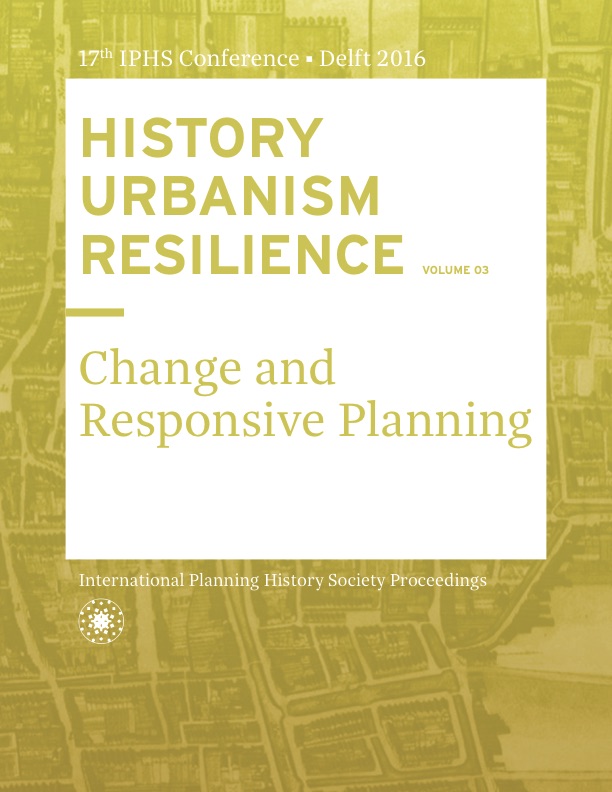Revitalization of a historical industrial port district - The goods station district in Antwerp
DOI:
https://doi.org/10.7480/iphs.2016.3.1252Abstract
Today the industrial heritage close to historic city centres is often part of major redevelopment projects. This is also the case for the former goods station district located in the north of Antwerp, close to the historic port of the city. The good station district was developed during the second half of the nineteenth century when new urban space became available after the demolition of the Spanish city walls in the 1860s. Henceforth, the city and its entrepreneurial citizens had the opportunity to develop a new industrial district with a goods station that linked the port with its hinterland. This industrial zone, which was highly productive during the second half of the nineteenth and the twentieth century, is characterized by many impressive warehouses. Recently however, this fascinating historic district started to undergo dramatic changes. The industry moved to the outskirts of the city and after a period of degeneration ambitious redevelopment plans were developed introducing new functions. The district is redeveloped as a residential district with offices. The vacant warehouses and factories attracted the attention of building promoters because of their valuable, large plots near the centre of the city. Some historic warehouses were demolished to make room for new office and apartment blocks, others were irreversibly changed. Although many warehouses still remain, their safeguarding is endangered by the speed and intensity by which the urban space is being redeveloped.It is, therefore, indispensable to rethink the value of the unique and diverse collection of remaining historical warehouses and their significance in the ever-changing fabric of the district. This paper aims to provide a scientific base to support the preservation and adaptive reuse of these warehouses, which still occupy large parts of the former goods station district. The paper analyses the planning history over the past 150 years of this particular district, located between the port and the goods station in Antwerp. Archival research (cadastral information, urban cartography and historic address books) allowed to define and to understand the establishment, functioning and evolution of the district. Additional research of building permits was necessary to define the historical importance of the warehouses, serving as a base to put forward criteria for their preservation. Furthermore, on-site investigations provided insight into the recent developments and were necessary to evaluate the reconversion projects of the warehouses and the changing integration of the latter in the urban fabric from a critical point of view. Finally, suggestions are formulated for respectful integration and renovation strategies. Henceforth, the study serves qualitative redevelopment projects as it is indeed essential to revalue historic industrial buildings in the evolving city centers and to investigate how this valuable heritage can be preserved for further generations.
References
Apostel, Katrijn. “Toelichtingsnota RUP 2060 Antwerpen”. Stad Antwerpen, 2012.
Bertels, Inge and Martens, Pieter. “Defunct defences: Antwerp’s sixteenth-century fortifications.” Future Anterior, Journal of Historic Preservation History, Theory and Criticism, III/2 (2006): 45-53.
Bertels, Inge and Van Goethem, Herman. “Vergankelijke stedelijke ruimte” In Antwerpen versterkt, De Spaanse Omwalling vanaf haar bouw in 1542 tot haar afbraak in 1870, edited by Piet Lombaerde, 118-145. Antwerp: University Press Antwerp, 2009.
Bertels, Inge; Bisschops, Tim and Blondé, Bruno. “Stadslandschap” In Antwerpen, Biografie van een stad, edited by Inge Bertels, Bert De Munck and Herman Van Goethem, 11-66. Antwerp: Meulenhoff/Manteau, 2010.
City of Antwerp. Risques commerciaux & intustriels. Rapport sur les Magasins, Entrepôts et Risques Industriels de la Ville d’Anvers. Antwerp: Ratinckx Frères, 1874.
Devos, Greta. Katoen natie 150 jaar (deel 1). Over kukhaken, pirrewitjes en natiepaarden. Tielt: Lannoo, 2003.
De Fossé, Marianne; Bertels, Inge; Vandenabeele, Louis and Wouters, Ine. “Understanding historical urban warehouses in Brussels: the architecture and construction of hay, timber, beer and textile warehouses.” Paper presented at the TICCIH Congress 2015: Industrial Heritage in the 21st Century, New Challenges, Lille, September 6-11, 2015.
Gils, Robert. “De Spaanse omwalling en de vesting Antwerpen” In Antwerpen versterkt, De Spaanse Omwalling vanaf haar bouw in 1542 tot haar afbraak in 1870, edited by Piet Lombaerde, 92-117. Antwerpen: University Press Antwerp, 2009.
Hein, Carola. “Port Cityscapes: A networked analysis of the built environment.” In Port Cities: Dynamic Landscapes and Global Networks, edited by Carola Hein, 2-10. London: Routledge, 2011.
Himler, Albert. “Stapelhuizen en opslagplaatsen” In Industriële revoluties in de provincie Antwerpen, edited by Roland Baetens, 341-358. Antwerp: Standaard, 1984.
Lorquet, Alix. Stadsontwikkeling in Antwerpen. Stad Antwerpen, 2012. http://www.ruimtelijkstructuurplanantwerpen.be/downloads/StadA_Stadsontwikk_DIGITAAL_DEF.pdf
Plomteux, Greet and Steyaert, Rita. Inventaris van het cultuurbezit in België, Architectuur, Stad Antwerpen, Bouwen door de eeuwen heen in Vlaanderen 3NB. Brussel: Brepols, 1989.
Plomteux, Greet and Steyaert, Rita. Inventaris van het cultuurbezit in België, Architectuur, Stad Antwerpen, Bouwen door de eeuwen heen in Vlaanderen 3NC. Brussel: Brepols, 1989.
Prims, Floris. Geschiedenis van Antwerpen VIII: Nederlandse en Belgische periode 1814-1914. Brussels: Uitgeverij Kultuur en Beschaving, 1985.
Thijs, Alfons. “Pakhuizen te Antwerpen in 1874, Een Balans van 100 Jaar.” Antwerpen, Tijdschrift van de Stad Antwerpen 21, no. 1 (1975): 16–25.
Vloeberghs, Guy. “De Antwerpse stadsuitbreidingen van eind 15de eeuw tot W.O.II. Ruimtelijke ontwikkelingen en hun maatschappelijke achtergronden.” PhD diss., Nationaal instituut voor Bouwkunst en Stedenbouw, Afdeling Stedenbouw en Ruimtelijke Planning, 1986.

